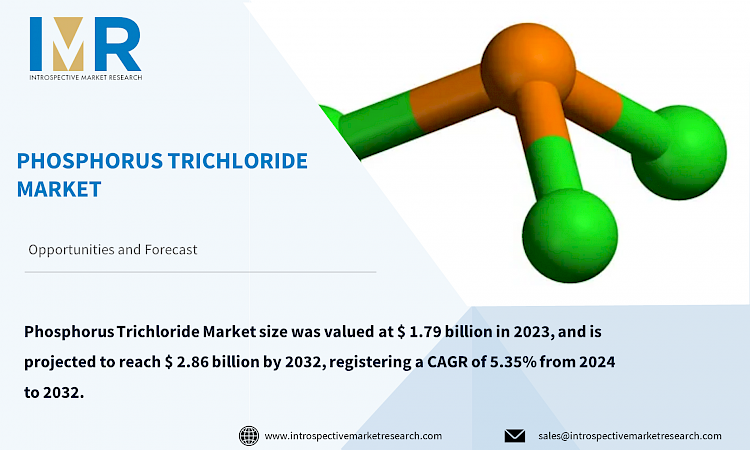
According to a new report published by Introspective Market Research, titled, “Phosphorus Trichloride Market by Grade, Application: Global Opportunity Analysis and Industry Forecast, 2024–2032,” the global Phosphorus Trichloride Market size was valued at $ 1.79 billion in 2023, and is projected to reach $ 2.86 billion by 2032, registering a CAGR of 5.35% from 2024 to 2032. Phosphorus trichloride (PCl3) is a chemical compound consisting of phosphorus and chlorine atoms. It appears as a colorless or pale yellow liquid with a pungent odor. For example, PCl3 is mostly used as a reagent in organic synthesis to convert alcohols to alkyl chlorides. It is also used in the production of pesticides, plasticizers and various medicines. PCl3 reacts strongly with water, releasing hydrochloric acid and phosphoric acids. Phosphorus trichloride (PCl3) is a colorless or slightly yellowish fuming liquid with a pungent odor, consisting of phosphorus and chlorine atoms. It plays a key role in industry as the main starting material for the synthesis of many different chemicals used in, for example, the pharmaceutical and chemical fields.
In various applications, PCl3 acts as an essential intermediate. This is particularly important in the production of agricultural chemicals such as pesticides and herbicides. In addition, it is a key component in producing phosphorus-based compounds important for pharmaceuticals, plastics and other chemical products. Its usefulness extends to the creation of flame retardants, water purifiers, and certain types of plastics. The adaptability of PCl3 in chemical synthesis comes from its flexible reactivity, which allows it to contact various organic compounds easily. However, caution is of the utmost importance when handling PCl3 due to its corrosive and toxic nature, which requires strict safety guidelines for transportation, storage, and use. The importance of phosphorus trichloride lies in its central role as a versatile intermediate that greatly facilitates the synthesis of various chemicals needed in industrial processes. It has a profound impact on the production of various end products in sectors such as agriculture, pharmaceuticals and chemicals.
The growing demand for agricultural chemicals is significantly boosting the growth of the phosphorus trichloride market. Agriculture plays a central role in meeting the food needs of a growing world population. Agrochemicals, including pesticides and herbicides, are widely used by farmers to optimize yield and quality. Phosphorus trichloride is an important element in the synthesis of various agricultural chemicals and acts as a basic building block in their production. The increasing need for high-quality, pest-resistant crops for food security increases the demand for agrochemicals, which increases the need for phosphorus trichloride. Farmers around the world rely on these chemicals to protect crops from pests, diseases and weeds, increasing agricultural productivity. The role of phosphorus trichloride in creating effective insecticides and herbicides contributes greatly to the efficiency and sustainability of the agricultural industry. In addition, demand for innovative and effective agrochemicals is increasing as agricultural practices evolve to meet challenges such as climate change and emerging resistance to pests. This growing demand for advanced agrochemicals, where phosphorus trichloride is still a key ingredient, is driving the continued growth of the phosphorus trichloride market. Its development is closely related to agricultural productivity and global food needs.
Emphasis on sustainable and environmentally friendly chemical practices presents a significant opportunity for the phosphorus trichloride market. As the environmental responsibility of industry is increasingly prioritized, there is a growing demand for chemicals and processes that minimize environmental impacts throughout their life cycle. Phosphorus trichloride, an essential compound in many industries, can achieve these sustainability goals through innovative approaches and green chemistry initiatives. One possibility involves the development of environmentally friendly synthetic routes for phosphorus trichloride. Research focuses on refining production methods to minimize waste, energy consumption and hazardous by-products. Adopting cleaner and more efficient production processes can reduce the environmental footprint of the industry by ensuring stable availability of this important compound. In addition, the use of phosphorus trichloride in the creation of environmentally friendly products further supports sustainable chemical initiatives. Researchers, manufacturers and end-users collaborate to research formulations that maintain or improve product performance while reducing environmental damage. This requires exploiting the reactivity of phosphorus trichloride to design compounds that are more biodegradable, less toxic, and have minimal environmental persistence. Investments in green chemical projects focusing on phosphorus trichloride not only provide environmentally friendly solutions, but also meet consumer demands for sustainable products. This environmental alignment creates opportunities for market expansion, allowing the phosphorus trichloride industry to thrive within sustainable practices and contribute positively to a greener future.
Global Phosphorus Trichloride Market, Segmentation
The Phosphorus Trichloride Market is segmented based on Grade, application, and region.
Grade:
The packaging type segment is further classified into Pure phosphorus trichloride, Analytical phosphorus trichloridex . Among these, the Pure phosphorus trichloride sub-segment accounted for the highest market share in 2023. The phosphorus trichloride market is mainly dominated by pure or ultrapure because it is very important in critical industries. Industries such as pharmaceuticals, electronics, and specialty chemicals rely heavily on ultrapure phosphorus trichloride due to its strict quality standards that are essential to the functionality of manufacturing processes and end products. In the pharmaceutical industry, where safety and efficacy are indisputable, ultrapure phosphorus trichloride is the basis for synthesizing active ingredients. Similarly, the electronics industry, which relies on reliable and dependable components, requires high-purity phosphorus trichloride for semiconductor manufacturing and other electronic applications. Even the smallest impurity in these areas can reduce the quality and performance of the final products, emphasizing the dominance of the high purity class. The dominance of this segment is strengthened due to its widespread use in various sectors with an emphasis on quality, precision and performance. This reinforces the position of ultra-pure phosphorus trichloride as the first choice to meet severe industrial requirements and ensures excellent end product quality.
Application:
The application segment is further classified into Agrochemicals, Chemical Intermediates, Pharmaceuticals, Plastics, Gasoline additives. Among these, the Agrochemicals sub-segment is anticipated to show the fastest growth by 2032. Phosphorus trichloride market segmentation based on application includes chemical intermediates, agricultural chemicals, gasoline additives, plasticizers, pharmaceuticals and others. The agrochemical segment dominated the market. The expansion of the phosphorus trichloride market is expected to be influenced by the high demand for this chemical in various end-use industries, including agrochemicals. Phosphorus trichloride is often used as an intermediate in pesticides in the field of agricultural chemistry. This substance is widely used in the production of organophosphorus herbicides such as glyphosate. A common active ingredient in herbicides, fungicides and insecticides is glyphosate, a type of pesticide.
Region:
The Phosphorus Trichloride Market in Asia-Pacific is projected to show the fastest growth by 2032. Asia Pacific defends its dominant position due to several key factors. Firstly, its strong industrial growth in various sectors including manufacturing, electronics and pharmaceuticals is driving the demand for phosphorus trichloride. Second, the prosperous economies of the region, especially China, India, Japan and South Korea, actively contribute to its governance by making significant investments in technological development and infrastructure. In addition, the presence of major producers in the region strengthens its position and ensures a consistent supply chain to meet the growing demand. The combination of these factors makes the Asia-Pacific region an important center for phosphorus trichloride, showing continued growth and strengthening its dominance in the global market.
Some of The Leading/Active Market Players Are-
- Lanxess Ag (Germany)
- Merck Kgaa (Germany)
- Bayer Ag (Germany)
- Solvay S.A. (Belgium)
- Monsanto Company (U.S.)
- Parchem Fine & Specialty Chemicals (U.S.)
- Pcc Rokita (Poland)
- Icl (Israel)
- Excel Industries Ltd (India)
- Aditya Birla Chemicals (India) and Other Active Players
Key Industry Developments
- In April 2023, Syngenta Crop Protection and Biotalys (Euronext-BTLS) announced a collaboration to research, develop, and commercialize new biocontrol solutions to manage key pests in a broad variety of crops. The new solution will be based on Biotalys’ AGROBODY technology and will offer a new mode of action to broaden farmers’ access to novel technologies that counter the threat of pest resistance and advance sustainable agriculture.
- In September 2022, specialty chemicals company LANXESS has developed a non-halogen flame retardant that will soon be offered under the brand name Emerald Innovation NH 500. The phosphorus-based additive is designed primarily for use in glass fiber-reinforced plastics used to manufacture products for the electrical and electronics (E&E) industry.
Key Findings of the Study
- The global Phosphorus Trichloride Market is expected to grow from $1.79 billion in 2023 to $2.86 billion by 2032, with a CAGR of 5.35% from 2024 to 2032, driven by its wide application in various industries, particularly in agriculture, pharmaceuticals, and chemicals.
- Pure phosphorus trichloride holds the highest market share due to its critical importance in industries like pharmaceuticals and electronics, where high purity standards are essential for manufacturing processes and end-product quality.
- The agrochemical segment is anticipated to experience the fastest growth by 2032, fueled by the increasing demand for agricultural chemicals to enhance crop yield and quality, which is essential for meeting the food needs of a growing global population.
- The Asia-Pacific region is projected to show the fastest growth in the Phosphorus Trichloride Market by 2032, supported by strong industrial growth, significant investments in technological development and infrastructure, and the presence of major producers in countries like China, India, Japan, and South Korea.




